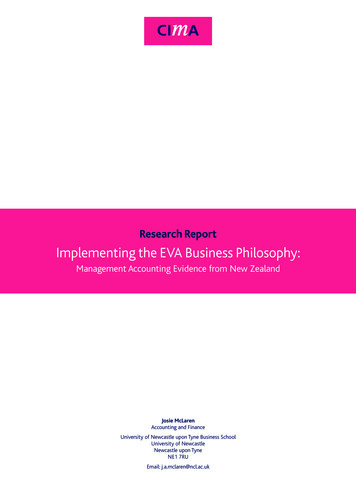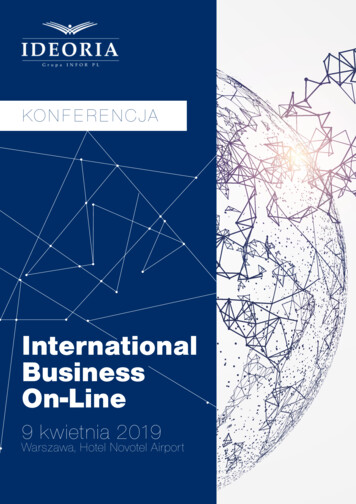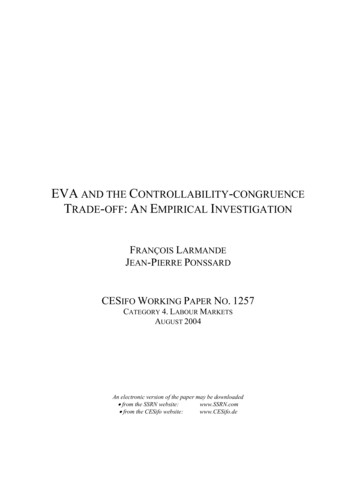
Transcription
Research ReportImplementing the EVA Business Philosophy:Management Accounting Evidence from New ZealandJosie McLarenAccounting and FinanceUniversity of Newcastle upon Tyne Business SchoolUniversity of NewcastleNewcastle upon TyneNE1 7RUEmail: j.a.mclaren@ncl.ac.uk
Copyright CIMA 2005First published in 2005 by:The Chartered Instituteof Management Accountants26 Chapter StreetLondon SW1P 4NPPrinted in Great BritainThe publishers of this document consider that it is aworthwhile contribution to discussion, without necessarilysharing the views expressed.No responsibility for loss occasioned to any person acting orrefraining from action as a result of any material in thispublication can be accepted by the authorsor the publishers.All rights reserved. No part of this publication may bereproduced, stored in a retrieval system, or transmitted, in anyform or by any means method or device, electronic (whethernow or hereafter known or developed), mechanical,photocopying, recorded or otherwise, without the priorpermission of the publishers.Translation requests should be submitted to CIMA.
Implementing the EVA Business PhilosophyContentsExecutive Summary . . . . . . . . . . . . . . . . . . . . . . . . . . . . . . . . . . . . . . . . . . . . . . . . . . . . . 21. Introduction . . . . . . . . . . . . . . . . . . . . . . . . . . . . . . . . . . . . . . . . . . . . . . . . . . . . . . . . . 32. What is EVA? . . . . . . . . . . . . . . . . . . . . . . . . . . . . . . . . . . . . . . . . . . . . . . . . . . . . . . . .2.1 The theoretical construct of EVA – the economic model . . . . . . . . . . . . . . . .2.2 The Practical construct of EVA – the accounting model. . . . . . . . . . . . . . . . .2.3 Accounting EVA and the economic construct . . . . . . . . . . . . . . . . . . . . . . . . .2.4 Is EVA a unique measure? . . . . . . . . . . . . . . . . . . . . . . . . . . . . . . . . . . . . . . . . . .2.5 EVA in the decentralised organisation . . . . . . . . . . . . . . . . . . . . . . . . . . . . . . . .2.6 Is EVA a unique solution to the benefit sharing philosophy?. . . . . . . . . . . . .2.7 Measures that compete with EVA . . . . . . . . . . . . . . . . . . . . . . . . . . . . . . . . . . .555666773. Obtaining the EVA Measure . . . . . . . . . . . . . . . . . . . . . . . . . . . . . . . . . . . . . . . . . . . 83.1 Feasibility of the measure . . . . . . . . . . . . . . . . . . . . . . . . . . . . . . . . . . . . . . . . . . 83.2 Factors to consider . . . . . . . . . . . . . . . . . . . . . . . . . . . . . . . . . . . . . . . . . . . . . . . . 84. Reasons for Implementing EVA . . . . . . . . . . . . . . . . . . . . . . . . . . . . . . . . . . . . . . . . 94.1 EVA as a complete measure of performance . . . . . . . . . . . . . . . . . . . . . . . . . . 94.2 Addressing the problems that are associated with thedecentralised organisation. . . . . . . . . . . . . . . . . . . . . . . . . . . . . . . . . . . . . . . . . . 94.2.1 Short-termism . . . . . . . . . . . . . . . . . . . . . . . . . . . . . . . . . . . . . . . . . . . . . . 94.2.2 Real investment options . . . . . . . . . . . . . . . . . . . . . . . . . . . . . . . . . . . . . . 94.2.3 Economic dependence . . . . . . . . . . . . . . . . . . . . . . . . . . . . . . . . . . . . . . . . 105. The Research Project . . . . . . . . . . . . . . . . . . . . . . . . . . . . . . . . . . . . . . . . . . . . . . . . . 115.1 Methodology . . . . . . . . . . . . . . . . . . . . . . . . . . . . . . . . . . . . . . . . . . . . . . . . . . . . . 115.2 Research methods. . . . . . . . . . . . . . . . . . . . . . . . . . . . . . . . . . . . . . . . . . . . . . . . . 115.3 Summary financial information on the case study companies . . . . . . . . . . . 12AcknowledgementsThanks must go first to the participantsfrom the three case study firms in NewZealand. They gave their time willinglyand were enthusiastic about the projectfrom the start. They provided lots ofsupporting documentation and Ireceived useful feedback on the results.Thanks also to participants at theBritish Accounting Association NorthernRegional Conference held in theDepartment of Accounting and Finance,University of Newcastle upon Tyne inSeptember 2001 and to members ofthe Department of Accounting andBusiness Method at the University ofEdinburgh who took part in a seminarin March 2001. Thanks finally to CIMAand the anonymous referees forsupporting the research and making theproject possible.6. Results from the Case Study Companies . . . . . . . . . . . . . . . . . . . . . . . . . . . . . . . 136.1 Initial implementation . . . . . . . . . . . . . . . . . . . . . . . . . . . . . . . . . . . . . . . . . . . . . 136.2 The Implementation process. . . . . . . . . . . . . . . . . . . . . . . . . . . . . . . . . . . . . . . . 136.3 The EVA philosophy within the firms today . . . . . . . . . . . . . . . . . . . . . . . . . . . 146.4 Feasibility of the measure . . . . . . . . . . . . . . . . . . . . . . . . . . . . . . . . . . . . . . . . . . 146.5 Measuring EVA. . . . . . . . . . . . . . . . . . . . . . . . . . . . . . . . . . . . . . . . . . . . . . . . . . . . 156.6 EVA as a complete measure . . . . . . . . . . . . . . . . . . . . . . . . . . . . . . . . . . . . . . . . 186.7 Addressing the problems that are associated with thedecentralised organisation. . . . . . . . . . . . . . . . . . . . . . . . . . . . . . . . . . . . . . . . . . 186.7.1 Short-termism . . . . . . . . . . . . . . . . . . . . . . . . . . . . . . . . . . . . . . . . . . . . . . 186.7.2 Real investment options . . . . . . . . . . . . . . . . . . . . . . . . . . . . . . . . . . . . . . 196.7.3 Economic dependence . . . . . . . . . . . . . . . . . . . . . . . . . . . . . . . . . . . . . . . . 197. Conclusions . . . . . . . . . . . . . . . . . . . . . . . . . . . . . . . . . . . . . . . . . . . . . . . . . . . . . . . . . 20Appendices. . . . . . . . . . . . . . . . . . . . . . . . . . . . . . . . . . . . . . . . . . . . . . . . . . . . . . . . . . . . . 22Appendix 1: The New Zealand Environment . . . . . . . . . . . . . . . . . . . . . . . . . . . . . 22Appendix 2: Alternative Value Based Metrics . . . . . . . . . . . . . . . . . . . . . . . . . . . . . 23Appendix 3: Results for Company 1 . . . . . . . . . . . . . . . . . . . . . . . . . . . . . . . . . . . . . 24Appendix 4: Results for Company 2 . . . . . . . . . . . . . . . . . . . . . . . . . . . . . . . . . . . . . 35Appendix 5: Results for Company 3 . . . . . . . . . . . . . . . . . . . . . . . . . . . . . . . . . . . . . 43References . . . . . . . . . . . . . . . . . . . . . . . . . . . . . . . . . . . . . . . . . . . . . . . . . . . . . . . . . . . . . 541
2Implementing the EVA Business PhilosophyExecutive SummaryThis publication presents case study evidence oneconomic value added (EVA ) from a managementaccounting perspective.The evidence is based on CIMA-sponsored research into threeNew Zealand companies that have been using EVA for anumber of years. The aim was to look at EVA in a businesscontext to discover how it has: replaced traditional measures used for planning,investment decision making and control, so is a completemeasure of performance; and addressed the problems that are associated with thedecentralised organisation such as those relating to shorttermism and economic dependence and therefore solvedconflicts of interest within the firm and between managersand shareholders.While there are many publications on the benefits of EVA(many from its promoter, Stern Stewart ConsultancyCompany), there has been little unbiased empirical researchon the companies that use EVA and their experiences. Thisresearch sought to close that gap by conducting detailedinterviews within each organisation to address the researchobjectives, with a particular emphasis on the dynamic natureof EVA systems over time.The evidence shows that EVA has not replaced traditionalmeasures. All of the companies make use of many othermeasures, both internally and externally. It also appears thatEVA cannot solve many of the problems associated with thedecentralised organisation and conflicts of interest still exist,in particular over economic dependence between units andshort-termism. Indeed, the calculation and use of EVA cancreate new problems. EVA may be misunderstood within theorganisation so that people mistrust the results. The way thatthe measure is used may also create adverse incentives.The companies dealt with these issues in different ways butthe common theme was that the calculation of EVA has beensimplified over time. Within each company, EVA wasoriginally introduced as a complex measure but it has beensimplified in order to improve objectivity and understanding– both of which are vital if EVA is to succeed.Does the evidence indicate that EVA has been oversold? Itmay be that EVA does not do all that has been promised byits promoters but the consistent view is that EVA has beenuseful. The rewards focus means that EVA delivers benefitsharing since the surpluses can be shared out after thereturns to capital providers have been recognised. It can alsolead to improved decision making-through a focus on capital,the cost of capital and the key drivers of value. These focalpoints had been missing before the introduction of EVA.Although the findings will not apply to all companies, theresults should be of interest to practitioners since theyaddress the pertinent issues concerning implementing andworking with an EVA financial management system.
Implementing the EVA Business Philosophy1. IntroductionThe notion of ‘benefit sharing’ has become an importantguiding philosophy in recent years. For a company, this meansthat all interested parties are recognised when addressing thefundamental question of ‘what are we trying to do in thisbusiness?’ The idea is that, by giving different parties – forexample, managers, other employees, customers andsuppliers – the chance of sharing in the benefits accruing to afirm, everybody will be better off. But how do you define‘better off’? To answer this, a company must consider firstwhether there should be one overall objective or a series ofobjectives (a ‘scorecard’) and then how to measureperformance against the objectives.Neo-classical economics would define value maximisation asthe single objective for all firms as this is when social welfareis maximised. Value is created when firms convert their inputsinto outputs of a higher value. In a theoretical or economicworld, product and factor markets are perfect and complete.All inputs and outputs have prices and capital assets havevalues and rental costs and income, so value is well defined.In addition to defining value at a point in time, we can lookat the increment in value for a firm from one period toanother. This increment is the economic value added (EVA). Itarises from the company adding value by buying assets thatgenerate cash flows. EVA can be defined as the surplus thatremains after deducting the cost of the investment over theperiod.However, in the real world we cannot use the economicmodel. Markets are incomplete and prices are not welldefined. In many cases prices are not observable becauseassets are not actively traded. Similarly, we do not have atraded market value of debt for estimating the cost of capital.All of which means we cannot have the economic constructof EVA. What we can do is build something that looks verysimilar to it based on accounting numbers – the accountingmodel. It is accounting EVA that is marketed by its developer,Stern Stewart, which promotes it as a complete financialmanagement system. It is argued that EVA, which is definedas net operating profit after tax (NOPAT) less a charge for allproviders of capital, can be pushed down the organisationand used in all dimensions of the business. The idea is thatmaximising EVA is consistent with the objective of valuemaximisation. EVA is also consistent with the notion ofbenefit sharing through the definition and use of value driversfor interested parties.In this respect, EVA fits in with ‘enlightened valuemaximisation’ as advocated by Jensen (2001). He says thatthe aim for a company should be value maximisation andthat structures must be put in place to ensure that allconstituents are considered. Value cannot be created if thecompany does not have good relations with customers,employees, suppliers and so on.Accounting EVA has long been advocated in the US and it isnow gaining in popularity in the UK. But does it really work?This question could be answered normatively or positively.Normative questions might address how EVA should work inthe organisation or how the measure should be constructed.Examples of research adopting this approach includeO’Hanlon and Peasnell (1998).Most positive studies to date have concentrated on claimsthat one particular measure, say EVA, is more highlycorrelated with share prices than other measures – examplesinclude Stark and Thomas (1998) and other studies such asthose mentioned in Ittner and Larker (1998). However,correlation is not sufficient. First of all, these studies do notconsider EVA beyond the corporate or firm level so there isno evidence presented on the philosophy of EVA in thedecentralised organisation. Second, there is no considerationof whether EVA is a complete measure and whether it canestablish the right incentives to ensure value maximisation.Third, there is no causation investigated: it is just correlation,so EVA cannot be said to cause any observed improvement inshare price.This research is unique in that it investigates EVA within theorganisation from a management accounting perspective,from corporate level down to business units. In particular, itconsiders EVA in a business context to discover the extent towhich EVA has: replaced traditional measures used for planning,investment decision making and control, so is a completemeasure of performance; and addressed the problems that are associated with thedecentralised organisation such as those relating to shorttermism and economic dependence and therefore solvedconflicts of interest within the firm and between managersand shareholders.The evidence is based on case study investigation of threecompanies that have worked with EVA for a number of years.Central to the investigation is whether EVA has been good forthe firms and whether it provides the right incentives toensure that the benefit sharing philosophy can be successful.3
4Implementing the EVA Business Philosophy IntroductionEvidence was gathered from interviews with participants atvarious levels within each company together with supportingdocuments. This approach meets the call in the article byIttner and Larker (op. cit.) for research that analyses factorsinfluencing adoption of value-based measures and theresulting performance consequences of such measures.Similarly, O’Hanlon and Peasnell (op. cit.) call for in-depthfield studies of the experiences of companies that haveimplemented EVA. Otley (1999) advocates the case studymethodology for the investigation of EVA within theorganisation.The three companies investigated are all based in NewZealand which was chosen for two reasons: several companies there have been working with EVA for anumber of years and so have a well-established trackrecord of EVA systems. This gives a picture of EVA overtime. some EVA companies in New Zealand are nationalisedcompanies, called State Owned Enterprises (SOEs). SomeSOEs publish EVA information in their financial statementsin comprehensive detail. SOEs differ from quotedcompanies in that they must operate under a Deed ofUnderstanding. This can affect the speed at whichcompanies can pursue actions to increase shareholdervalue. The research considered two SOEs and so was ableto investigate the extent to which management accountingsystems are driven by financial reporting requirements. Italso explored the differences in EVA between thesecompanies and the third company, a firm quoted on theNew Zealand stock exchange.Facts about the New Zealand environment, including a briefoutline of the characteristics of SOEs, are presented inappendix I. The following three sections of the report providebackground information on EVA, including what is EVA(section 2), obtaining the EVA measure (section 3) and thereasons for implementing EVA (section 4). Alternativemeasures to EVA are presented in appendix II. Section 5outlines the research methodology, with the evidencepresented in section 6. Supporting results from which theevidence is drawn are presented for the three companies inappendices III-V respectively, using the framework foranalysis suggested by Otley (op. cit.). Section 7 concludes.
Implementing the EVA Business Philosophy2. What is EVA?In thinking about what we mean by EVA, it is important toconsider the differences between the theoretical notion ofeconomic value added and the practical or real world conceptof EVA. We can then consider how EVA might be measuredand applied in practice in the decentralised organisation.2.1 The theoretical construct of EVA –the economic modelIn a theoretical or economic world, product and factormarkets are perfect and complete. All inputs and outputshave prices and capital assets have values, rental costs andincome, so value is well defined. There is a price foreverything for every possible state of the world. Firms cannow create value by investing in projects that have a positivenet present value (NPV), which is the theoretically correctmodel for investment appraisal in this market setting. There isno difficulty in obtaining a value for any real investmentoptions that might exist, as we have perfect and completemarkets. What’s more, we can use a more general model ofvaluation in this economic setting – risk neutral valuation.As well as defining value at a point in time, we can look atthe increment in value for a firm from one period to another.This increment is the economic value added over the timeperiod. It arises from the company adding value by buyingassets that generate cash flows. EVA can be defined as thesurplus that remains after deducting the cost of theinvestment over the period:Equation 2.1.12.2 The practical construct of EVA –the accounting modelIn reality, we cannot use the economic model. Markets areincomplete and prices are not well defined. In many casesprices are not observable because assets are not activelytraded. Similarly, we do not have a traded market value ofdebt for estimating the cost of capital. The consequence ofthis is that we cannot have the economic construct of EVA.What we can do is build something similar based onaccounting numbers – the accounting model.In the accounting model, value is based on the accountingmeasure of capital.The definition of accounting EVA is:Equation 2.2.1EVAt NOPATt – (Capitalt-1 x WACCt)Where Economic value added for time period tEVAtNOPATt Net (after depreciation) operating profitafter tax for time tCapitalt-1 Book value of debt plus equity capitalat the start of time tWACCt Estimated weighted average cost of capitalto the providers of finance, which will bebased on book value weight of debt returnand the book or the market value weightof equity return.EVAt Ct – (Capitalt-1 x WACCt)Where EVAt CtCapitalt-1 WACCt Economic value added for time period tCash flow for time tMarket value of capital at the start of time tWeighted average cost of capital(based on market values)The term in brackets in equation 2.1.1 is the cost of theinvestment. This reflects the amount that providers of financeshould expect to earn in the market over time period t. In thistheoretical world all cash flows and market values can bemeasured. There is no ambiguity over the EVA measure: it isunique. However, in this framework EVA is a redundantconstruct. It arises as a by-product from the valuation processand it is not necessary, as values are well defined. This is theargument for the irrelevance of economic income (Beaverand Demski, 1979).This measure of EVA is clearly made at the operating level. Itis not defined as the surplus to shareholders. The implicitassumption is that maximising the total surplus to capitalproviders is the same as maximising shareholder wealth. Inother words, debt holders do not share in any positive NPV,they just earn the appropriate rate of return.Equation 2.2.1 gives the natural definition for EVA that isbased on accounting variables. EVA is the increment to profitover and above the capital charge. This is a clear definition ofEVA that will hold for all companies.5
6Implementing the EVA Business Philosophy What is EVA?2.3 Accounting EVA and the economic constructFor several years, much of the debate on incomemeasurement centred on the premise that the economicconstruct of income is the ‘ideal’ measure, with accountingmeasures viewed as inferior or imperfect. Faced with therealisation that we must work with accounting numbers, theobjective has been to define a measure that is as close aspossible to the theoretical economic ideal. However, such anobjective is fruitless. The theoretical ideal is just that, an ideal.It cannot be measured, so how do we know if we are close toit? If we could work within this theoretical world we wouldnot need measures of income anyway. It also relates to aneconomic environment which is not the reality of business.This is the Beaver argument that has already been alluded to.The argument carries across to EVA. We are not attemptingto measure ‘true’ economic value added using an ‘imperfect’construct derived from accounting numbers. We should noteven pretend to do so. We have with accounting EVA thepossibility of using accounting numbers to define aneconomically meaningful measure that is useful internallyand to those outside the firm.2.4 Is EVA a unique measure?Even though we can write the definition for accounting EVA,the actual measurement of EVA will vary across firms. EVA isnot a unique measure. It will depend on accounting policyand is affected by what appears on the balance sheet andwhat goes through the profit and loss account. Indeed SternStewart talks of the possibility of more than 160 adjustmentsto accounting numbers, although it says that, in reality, onlyaround 20 adjustments will be relevant for an individual firm.The adjustments, which include for example the capitalisingrather than the expensing of research and development, aredesigned to make the EVA measure more economicallyuseful.2.5 EVA in the decentralised organisationThe measure of EVA can be drilled down the organisation andcalculated at the divisional, process or product level. It isimportant that the organisation is decentralised withdevolved decision rights since the secondary measures lie atthe lower levels of the organisation. For example, it is at theselevels that we have the interface with employees, customersand suppliers. This means that EVA may not be suitable incountries with a culture of centralised organisations, such asin the Middle East.When EVA is mapped through the organisation, individualEVAs sum back to yield the overall firm EVA, as illustrated inFigure 2.5.1.Figure 2.5.1 EVA in the decentralised organisation: divisions and business unitsCorporate LevelEVA EVA (1) EVA (2) EVA (3)Division (1)EVA (1)Division (2)EVA (2) EVA (a) EVA (b)Business Unit (a)EVA (a)Business Unit (b)EVA (b)Division (3)EVA (3)
Implementing the EVA Business Philosophy What is EVA?Figure 2.5.2 EVA in the interdependent decentralised organisationCorporate LevelEVA EVA (1) EVA (2) EVA (3)Division (1)EVA (1)Division (2)EVA (2) EVA (a) EVA (b)Business Unit (a)EVA (a)In a firm made up of economically independent units,managers can be briefed to maximise their individualmeasures of EVA in the knowledge that this will ensure thatoverall EVA will also be maximised. In reality, decentralisedorganisations comprise a series of interdependentcomponents with complicated linkages, as illustrated inFigure 2.5.2.The arrows in Figure 2.5.2 indicate potential areas ofinterdependence, for example, over shared costs andrevenues, transfer pricing of services and the allocation ofcentral costs. These are discussed more fully below. Of course,the organisation may be much more complicated with manymore intricate relationships.In an organisation where there is dependence between units,EVA can still work when it is pushed down the organisation. Itwill work if the control function (the corporate function orexecutive board) establishes trade-offs between the units todeal with the interdependencies including dealing jointly withcosts and revenues, transfer pricing and other impacts. Sincelike is being measured with like, it is in theory possible toestablish these trade-offs. This is not necessarily the case withprofit because it ignores the capital commitment.2.6 Is EVA a unique solution to thebenefit sharing philosophy?The philosophy and ideas behind benefit sharing wereinstigated in the 1970s and 1980s with the pioneering workof Rappaport, who developed ‘shareholder value analysis’,based on the identification of key drivers of value for firms(see Rappaport (1986)). This philosophy of benefit sharing isnot unique to EVA. The balanced scorecard approach, asadvocated by Kaplan and Norton (1992, 1993, 1996a, 1996b,2001a and 2001b) is an example of this philosophy, wherethere is an emphasis on balancing the interests in thebusiness. Jensen (op. cit.) describes the balanced scorecard asthe ‘managerial equivalent of stakeholder theory’. He saysDivision (3)EVA (3)Business Unit (b)EVA (b)that the difference between the balanced scorecard and EVAis that the balanced scorecard gives no score – that is, nosingle measure of how a manager or a company hasperformed. As a consequence, managers have no guidance onhow to establish the inevitable trade-offs that occur betweenthe various interests. Without the appropriate incentives anddirection, they can seek to act in their own best interests tomaximise their remuneration.EVA and the balanced scorecard are not conflictingphilosophies. Indeed, the idea of ‘taking EVA all the way downto the shop floor’ is now regarded by some as impractical incertain situations (see Young and O’Byrne 2000). Instead, thefocus at lower levels of the company is on the drivers of EVA,financial and non-financial, leading to a balanced scorecardapproach. This suggests that the balanced scorecard and EVAare regarded as complementary systems. In effect EVA is splitinto its separate components, or value drivers, for thesecondary stakeholders. These are then used to construct thebalanced scorecard for the firm, unit or sub-unit. EVA mightappear as one measure in the scorecard. The key differencebetween EVA and the balanced scorecard is that EVAcollapses all the elements into one number.2.7 Measures that compete with EVASince EVA is not a unique measure, what about itscompetitors? An array of consultancy firms have made theirmark through promoting their own particular performancemeasures, all of which claim to be the best at ensuring thatthe primary objective of shareholder wealth maximisation ismet. That companies are willing to buy into one or more ofthese measures illustrates the persuasiveness of theconsultants and also perhaps dissatisfaction with moretraditional performance measurement systems. The variety ofvalue-based metrics can be classified along differentdimensions according to their characteristics. A simpleclassification is provided in appendix II, together withexamples of performance metrics in each of the categories.7
8Implementing the EVA Business Philosophy3. Obtaining the EVA Measure3.1 Feasibility of the measureIf a company wants to adopt the EVA philosophy it must beable to measure EVA down through the organisation.Although this seems obvious, it is something that SternStewart does not dwell on. Young and O’Byrne (op. cit.)suggest that units or divisions could be grouped together tomeasure EVA when there are difficulties in obtaining a finermeasurement. However, they note that there are potentialdrawbacks to this solution, including the addition of anotherlayer of management and the free-rider problem.A general rise in interest rates or the market means a rise inthe cost of capital. With rewards based on EVA, thispotentially affects managerial compensation. One way toavoid this problem is to use a constant cost of capital overtime. The estimate could be a company-wide cost of capital.However, this may not adequately reflect the risk of businessunits or the projects in which they invest. The cost of capitalmay be regarded as subjective if it is believed that risk is notadequately reflected. However, if the cost of capital variesacross business units, it may create tensions within the firm.Corporate structure is another important factor in thefeasibility of the measure of EVA. If the firm reorganisesfrequently, there is no history for the calculation andmonitoring of EVA growth over time. What happens to anypositive or negative EVA? Does it follow the manager sincethere is no longer a unit in which it can reside?Jointness over revenues and costs, assets and liabilitiesJointness over costs and revenues will inevitably arise in adecentralised organisation, particularly a network business.Shared revenues include, for example, revenue from bundlinggoods or services that go across business units. Similarly,costs may also be bundled, for example, advertising. Unlessthese costs and benefits can be broken down and pricedseparately for all units of the company, a satisfactory meansof allocating these costs and benefits has to be devised. Anyallocation will inevitably involve judgement, leading tosubjectivity in the measure.3.2 Factors to considerThere must be agreement as to: the adjustments to GAAP to obtain the EVA figure;the cost of capital;jointness over revenues, costs, assets and liabilities;allocated costs; andappropriate value drivers for each unit or sub-unit.AdjustmentsMeasurement can have an impact on managerial behaviou
organisation from a management accounting perspective, from corporate level down to business units. In particular, it considers EVA in a business context to discover the extent to which EVA has: replaced traditional measures used for planning, investment decision making and control, so is a complete measure of performance; and










